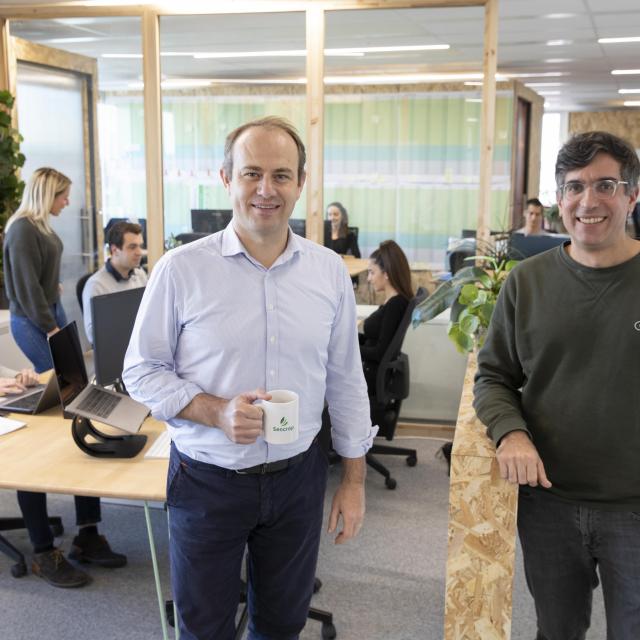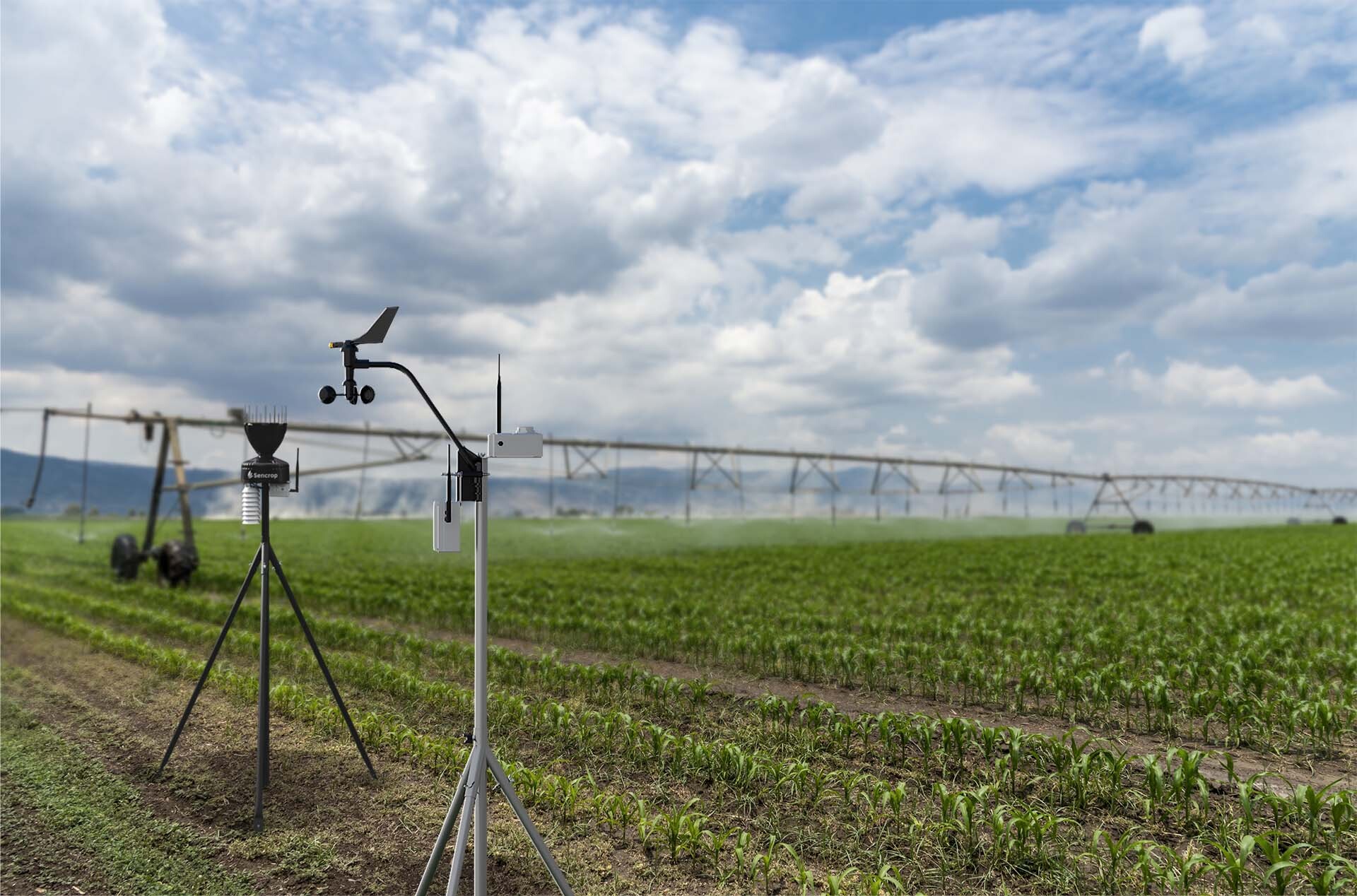Martin Ducroquet and Michaël Bruniaux met at Euratechnologies, the largest incubator in Europe, based in Lille, France. Martin grew up in a farming family. After graduating from business school, he created his first company in the food tech industry. As for Michael, he is an Electrical and Computer-Aided Engineering. He has also founded another company in AgTech. Aware of how they could complement each other, they decided to go into partnership and founded Sencrop in 2016.

They became successful by producing collaborative solutions based on the collection of agro-meteorological data. Weather stations installed directly on the farmers' plots of land send multiple data (rainfall, temperature, air humidity, wind speed) every 15 minutes to the Sencrop application installed on farmers' phones and computers. This information allows farmers to organize their cropping calendar, reduce the frequency and quantity of the application of inputs, set up alerts for particular weather conditions such as frost and make assessments at the end of the season.
Very fast growth
In 2016, Michael and Martin launched their first general purpose product, Raincrop, a connected rain gauge that provides ultra-local and reliable data, which is essential for precision agriculture: rainfall, air temperature, wet-bulb temperature and dew point. Initially the product was sold to potato farmers in the north of France.
In 2017, Raincrop won an award at the Sima show, which will enhance their reputation and bring them new development opportunities. The collaborative aspect of the product, its ease of use and low price impressed the show’s organisers. Sencrop then moved into the cereals, sugarbeet and maize (corn) markets.
In 2017, after the sharp spring frosts, Sencrop returned to the Loire Valley and began to equip the wine-growers. Furthermore, the company began to expand internationally on the very technical Dutch market.
In 2018, Sencrop continued its international growth by setting up sales teams in the United Kingdom and Spain.
In 2019, Sencrop moved into the arboriculture (tree-growing) market in the south of France and Spain. They were able to obtain significant funding in an amount of 10 million euros, enabling our two founders to progress: the number of people working at the company doubled (from 20 to 40 employees).
In 2019, they received a medal in the Sival competition for its wetness sensor (Leafcrop) which allows the farmers, wine-growers and tree-growers to obtain the most precise and reliable information from the heart of the orchards or vineyards. This data, sent directly to the application, helps prevent diseases (mildew, powdery mildew , scab…), knowing when to treat the plots and mitigating the risks of frost through a system of customisable alerts.
Sencrop acquired Visio-Green Agriculture in 2020, a subsidiary of the Latitude GPS group, which specialises in connected solutions for agriculture. This merger will enable Sencrop to increase its existing network to more than 21,000 stations, the largest in Western Europe.
In 2020 the company also moved to its current premises, not far from the incubator.
Sencrop now has more than 80 employees, a third of whom are women; the average age is 27 years old.
The company has more than 300 networks (from wine-growers’ unions to irrigation trade associations, from wine-growers’ associations - GDV - or agricultural research centres – CETA - to cooperatives, shops and chambers of agriculture) and 25,000 weather stations installed in 7 European countries: France, Netherlands, Belgium, Germany, United Kingdom, Italy and Spain. Their clients have very different profiles; they are wine-growers, tree-growers or arable farmers. They practice conventional or organic farming, on different-sized farms.
Sencrop launched Irricrop in 2022
Irricrop was designed around three criteria, three types of recurring problems faced by farmers today: weather conditions and risks such as frosts or other local climatic events. The threat posed by disease and pests, managing plant water and optimising irrigation.
“Irrigation makes sense in the face of the problems confronting European farmers,” explains Martin Ducroquet. “Moreover, 30 to 35% of our customers use irrigation”.
In Europe, 25% of the fresh water abstracted is consumed by agriculture and sprinkling accounts for 70% of all irrigation. In 2010, the European Commission estimated that Europe could reduce its water consumption by 40% through the optimisation of the irrigation systems.
That’s why our startuppers decided to develop Irricrop, a complete weather station connected to an application that enables the farmer to measure the plot’s water requirements.
The pack consists of three weather stations connected to the Sencrop application :
• RainCrop is a connected rain gauge designed to capture precise measurements from the field, such as accumulated rainfall, temperatures, moisture content, wetted bulb temperature and dew point.
• The Windcrop-connected wind gauge encourages precise, efficient and effective farming practices, in compliance with European recommendations. It provides farmers with reliable and ultra-local agro-weather data, measuring wind speed, wind direction and gusts. The data collected allows the user to forecast weather conditions that will be favourable for spraying.
• Finally, we have this year’s new product, Solarcrop, which measure the irradiance, i.e. the solar radiation or light received by the field.
“These three tools enable the user to calculate the field’s potential evapotranspiration or ETP”, explained Bruno Boissenin, the engineer who developed SolarCrop.
Let us remind ourselves that the potential evapotranspiration of a soil is defined as the amount of evaporation that could be produced when there is an adequate soil water status. Just like the precipitations (rain, snow, etc.), the evapotranspiration rate is expressed in terms of the equivalent depth of water lost over a given period (e.g. mm per year, per month, per day).
The farmer must then add an extremely important item of data to his or her application: the composition of the soil (the percentage clay, silt and sand).
Finally, the type of crop being grown in the plot must be specified. Vincent Munoz, Product Designer at Sencrop, who developed the application, explained: “We have used the FAO data base which links the type of crop to the water requirements according to the region and soil type”.
The data gathered, the observation and the weather forecasts are interconnected in the application’s interface.
The farmer then has a summary of the data on his or her mobile phone or computer: this will show the name of the plot and type of crop, the amount of water available in the soil, the evapotranspiration, rainfall and irrigation in mm per day. And below, there will be a very user-friendly graph showing the amount of water retained in the plot. When it moves from the green zone to the yellow zone, then the user knows that he or she must irrigate.
“The application indicates when it is necessary to irrigate and the amount to be applied”, explained Vincent. And he continues: “and a farmer who grows wheat or maize (corn) will receive advice for each crop”.
The complete pack costs €1,400 and the subscription is €400 for the application.
Where should the weather station be placed on the farm?
The positioning of the weather station on the farm is also very important. If it is possible to have only one station on the farm; it must then be located far from any obstacles and away from windy locations. On the other hand, if there should be any obstacles such as a forest or a river or if the farm should be at a high altitude, this will change the data and thus several weather stations may have to be installed.
Why hasn’t a capacitance sensor been developed so real measurements can be taken of what is actually happening in the soil?
“This is a question that we are often asked by the farmers”, explained Martin.
First and foremost, Michaël and Martin wanted to focus on ease-of-use for the farmers. However, tensiometers or capacitance sensors are complicated to install. You have to determine the type of soil you are in and be sure to position the sensor in the place where the sample measurements are to be taken. The farmer must know how to use sensors, which not everyone can manage.
Furthermore, even with a sensor, the advice given to the farmer still requires further calculations. The farmer will be given agronomic or irrigation advice for the type of soil prevalent at the farm location.
Nevertheless, Sencrop has entered into a co-operation agreement with Corhize and offers the sensors as an Irricrop accessory to the laboratories with which they work. Actually, if the famers ask for it, we do propose their tensiometers.
Sencrop has 25,000 weather stations installed in Europe, and all the data is uploaded and processed in the application. Furthermore, Sencrop has a portfolio of 300 major accounts, including agricultural groups, cooperatives, irrigation associations…
Apart from having customised advice for the management of their crops, the farmers are connected to outside partners and they have access to a very wide range of data on the different markets.
The company has grown very rapidly, in only 6 years. The keys to Sencrop’s success are: an easy-to-use product, affordable and a community of connected European farmers who share their agronomic data.

